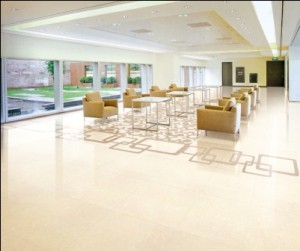Difference between Vitrified Tiles and Rectified Tiles
Key Difference: Vitrified tiles possess the property of less water retention and these tiles are popular for their strength and stain-resistance. On the other hand, rectified tiles or sharp edge tiles have plain and square edges and are first baked and then cut in to desirable shapes.
Floors and walls are the important elements of a house or any building. People use various things in order to decorate the floors and walls. Tiles are used to enhance the beauty of the walls and floors. These tiles are also used as they are easy to clean and mostly easy to maintain. A lot of variety is available in the market in context to these tiles. People choose the tiles that suite their budget and are perfect for their walls or floors. Two words that are often heard in the tiles market are vitrified and rectified.
 Vitrified tiles relate to the word ‘vitrify’ that refers to the phrase 'change into glass' or 'something that appears almost like a glass'. Vitrified tiles are composed of a mixture containing silica and clay. This mixture is used to form a non-porous tile that has a glassy texture. The key word here is ‘vitrification’.
Vitrified tiles relate to the word ‘vitrify’ that refers to the phrase 'change into glass' or 'something that appears almost like a glass'. Vitrified tiles are composed of a mixture containing silica and clay. This mixture is used to form a non-porous tile that has a glassy texture. The key word here is ‘vitrification’.
The process that is used in vitrified tiles is related to the vitrification process and thus, these tiles posses a look similar to the glass. These tiles are non-porous and thus are considered to be very durable. Vitrified porcelain tiles are an example of these kinds of tiles. The vitrified porcelain tiles are produced by a mixture of kaolin clays, quartz, and feldspar and then the mixture is fired at 1200-1300 degrees, in order to make uniform and compact tiles. The vitrified tiles water absorption is around 0.5 to 3 percent of its weight. Therefore, these tiles are suitable for both dry as well as wet areas.
The advantages of these tiles are listed below :-
- Can be cleaned by using bleach and detergents
- Easy maintenance
- Difficult to stain
- Durable
- More solid than natural granite
- Withstand the acids and not effected by scratches
- Laying and setting time is very less.
The word ‘rectified’ for the tiles can also be associated with the manufactured tiles such as porcelain. A rectified tile is first baked and then cut into similar sections. The edges are mechanically finished in order to receive a precise dimension. Thus, similar kind of tiles are obtained. However, in other cases the process of baking usually shrinks the tiles. Rectified tiles are of same size and thus it is easier to work with these tiles. These tiles are mechanically finished on all sides. They are generally made from the mix of marble and granite powder under high pressure.
The size of these tiles is just optimum and therefore, these tiles can be placed much closer. These tiles are comparatively expensive as the cost of cutting down to the desired size is also added. The cost of laying these tiles is also generally higher as it requires more time, care and flatter substrate. These tiles assist in keeping a uniform and consistent layout. One can also expect really small grout lines with these tiles.
Therefore, we can say that a particular process defines the type of these tiles. Any tile made by the process of vitrification is referred to as a vitrified tile whereas, any tile that is baked first and cut later is known as a rectified tile. Vitrified tiles are scratch resistant, whereas rectified tiles may or may not be scratch resistant, depending on the type of the mixture.
Image Courtesy: tfo.com.au, canaroma.ca









Comments
JasonTaylor
Mon, 03/20/2017 - 21:45
Add new comment